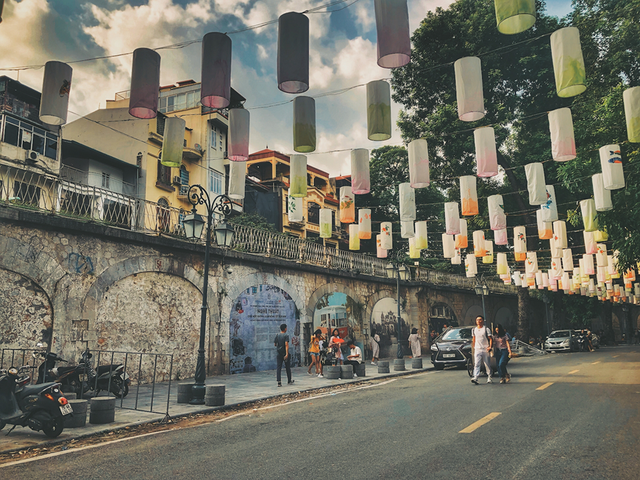Planning focuses on unique cultural space
VGP - The Ha Noi’s upcoming planning for the 2021-2030 period, with a vision to 2050 would be to create fresh opportunities for development by promoting unique cultural spaces, and in turn, harnessing their potential as valuable resources for growth.

Phung Hung Mural Street is located in the heart of the Hoan Kiem District
Throughout a series of seminars conducted from August 2023, discussing strategies to advance industries, sectors, and regional integration within Ha Noi's Capital Planning, the Vice Chairman of the Ha Noi People's Committee, Ha Minh Hai, consistently highlighted the paramount importance of cultural and human resources for Ha Noi's sustainable development.
Expanding cultural spaces
A key focus lies in expanding cultural spaces to effectively harness heritage for the city's growth. Consequently, the consulting unit responsible for drafting the planning has initiated preliminary research to shape distinctive cultural spaces for the capital.
They have proposed the development of both sides of the Red River to form a cultural corridor that is intricately connected to tourism development and linked with the historic Thang Long - Co Loa Imperial Citadel. This initiative aims to bridge the gap between the city's historic core and its eastern gateway.
To illustrate, the National Institute of Urban and Rural Planning, a member of the consulting consortium, has devised plans for a viaduct flanking both sides of the Red River, which is envisioned as a "heritage route" catering to tourism needs. On the right bank of the river, a "heritage road" will showcase the nation's history of construction and defense.
The central part of the city will include Ha Noi's historic road, commemorating the "60 Days and Nights" battle in 1946-1947, a crucial period in Viet Nam's fight for independence from French colonial rule.
Meanwhile, the route on the left bank of the Red River will serve as the "Viet Nam, Land, and People" pathway, introducing the splendid natural landscapes of various regions of Viet Nam.
This multi-faceted space will also serve as a venue for organizing cultural festivals, attracting localities from across the nation to showcase and promote tourism.
Moreover, urban underground space planning within the metropolitan area is designed to preserve and curb construction in the Old Quarter. A key facet of this plan involves developing the West Lake area as a cultural and public hub, fostering tourism, and maximizing the natural beauty of this site, to make it a prominent feature of the capital.
Harnessing the rich cultural potential of the West Lake area would contribute to the transformation of Ha Noi into a green, civilized, and modern city.
Planning for future growth and heritage preservation
Phan Dang Son, the Chairman of the Viet Nam Association of Architects, noted that Ha Noi is striving for a model of development that is both civilized and modern, but it currently lacks space for cultural growth and the cultural industry.
Therefore, it becomes imperative to establish unique urban areas dedicated to cultural development in the city's planning to effectively craft a model of a civilized, modern, and prosperous city.
Supporting this viewpoint, Nguyen Tien Minh, the Secretary of the Thuong Tin District Party Committee, emphasizes that in the foreseeable future, Hanoi should focus on promoting the cultural industry and development. There is also a proposal to revive the cultural heritage of the Tran Dynasty's Imperial Citadel, serving as a significant attraction to draw visitors.
Concerning the Red River alluvial islet, there is a suggestion to plan for the creation of an ecological, cultural, and sports tourism zone in the area under Thuong Tin District. This plan includes the construction of a golf course and the restoration of the legend of Tien Dung - Chu Dong Tu. It will be complemented by Van Tu Thuong Phuc, a site to pay tribute to the rich academic tradition of this renowned and heroic land.
Professor Dr. Nguyen Quang Ngoc, Vice President of the Vietnam Association of Historical Sciences, expects Hanoi to give special emphasis to the development of cultural spaces and landmarks in the upcoming planning.
Foremost among these is the Thang Long Imperial Citadel, a symbol of Thang Long – Ha Noi, and an emblem of Dai Viet cultural heritage which has been recognized as a world cultural heritage site. However, challenges remain in terms of planning, management, preservation, and promotion, and there is still ongoing confusion in this regard.
Additionally, the special national relic of Co Loa Citadel, the largest land citadel and the oldest military and royal citadel in the entire Southeast Asian region, remains largely intact to this day. Nevertheless, the rapid pace of urbanization in Dong Anh is posing a constant threat to these precious relics.
In addition to these, there is a need to foster the development of Ha Noi's old quarter, several ancient villages, distinctive craft villages, and the ambitious project to transform the To Lich River into a historical, cultural, and spiritual park.
"Capital planning must provide a clear direction to bolster cultural values and the cultural industry. This will enable Hanoi to evolve into a modern, dynamic, and civilized city while preserving its ancient characteristics and enduring cultural and historical legacy as the cradle of Thang Long's millennia-old civilization," Ngoc said./.

